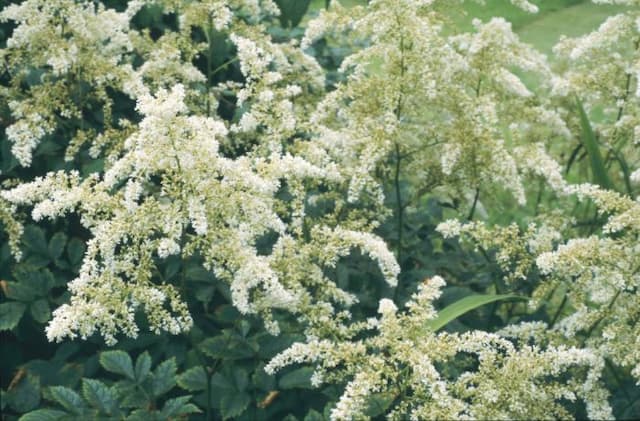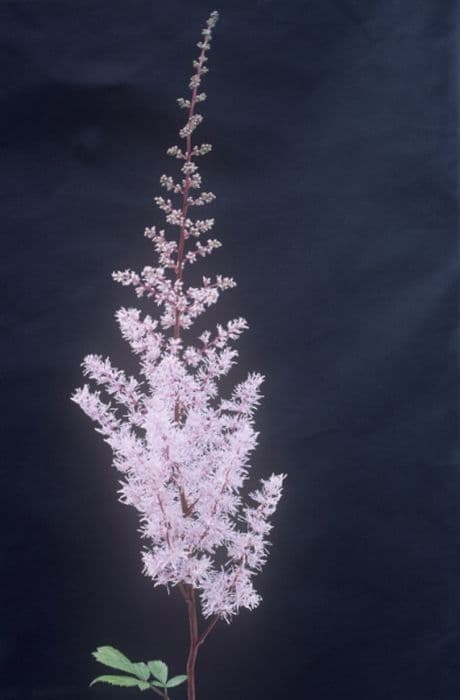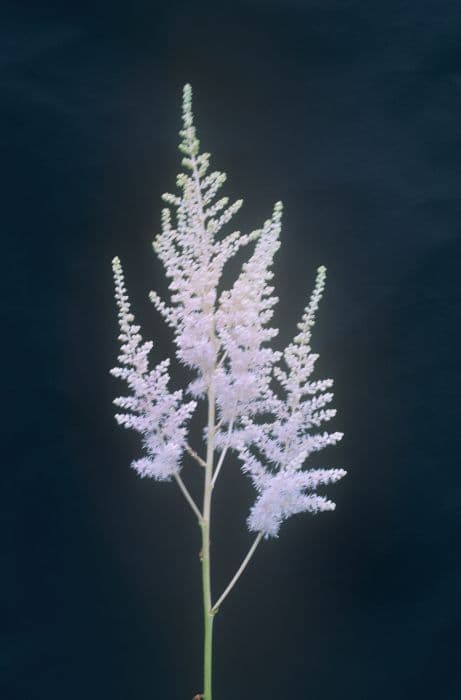Elephant's ears Bergenia 'Abendglocken'

ABOUT
Bergenia 'Abendglocken', commonly known as Elephant's Ears, features a rosette of large, glossy, oval leaves that are leathery in texture. These leaves typically display a rich dark green color but can turn to reddish-bronze or purple hues in colder weather, providing year-round interest. In spring, Elephant's Ears boast tall stems rising above the foliage, adorned with clusters of bell-shaped flowers. The blooms exhibit a deep pink or magenta color, making them a striking addition to any garden. The flowers are attractive to pollinators such as bees and butterflies, adding an element of liveliness to the plant's appearance. Elephant's Ears presents a robust and lush look, with its foliage providing a substantial ground cover and the vibrant flowers creating height and visual appeal during blooming season.
About this plant
 Names
NamesFamily
Saxifragaceae
Synonyms
Evening Bells, Abendglocken Bergenia
Common names
Bergenia 'Abendglocken'
 Toxicity
ToxicityTo humans
Bergenia 'Abendglocken', commonly known as Elephant's Ears, Plant is generally considered non-toxic to humans. There is no significant evidence that ingestion of any part of this plant causes poisoning or adverse health effects in people. Therefore, while consumption is not recommended, it is not expected to lead to poisoning symptoms.
To pets
Elephant's Ears is typically safe for pets as well, as there is no indication that the plant is toxic to animals. Similar to its effects on humans, ingestion of the Bergenia 'Abendglocken' by pets is not expected to cause poisoning symptoms or significant health concerns. Pet owners should always monitor their animals for any signs of distress after ingesting plants, but Elephant's Ears is not known to be a cause of concern.
 Characteristics
CharacteristicsLife cycle
Perennials
Foliage type
Evergreen
Color of leaves
Green
Flower color
Pink
Height
1 foot 6 inches (45 centimeters)
Spread
1 foot (30 centimeters)
Plant type
Herb
Hardiness zones
3
Native area
Asia
Benefits
 General Benefits
General Benefits- Low Maintenance: Bergenia is known for being easy to care for, with minimal pruning and watering requirements once established.
- Tolerant of a Wide Range of Conditions: It can thrive in various soil types and pH levels, as well as tolerate some degree of urban pollution.
- Year-Round Interest: The plant often retains its attractive leaves throughout the year, providing visual interest in all seasons.
- Drought-Resistant: Once established, Bergenia can withstand periods of dry conditions, making it suitable for xeriscaping.
- Attracts Wildlife: The flowers can attract bees and butterflies, beneficial for pollination and supporting biodiversity.
- Ground Cover: The dense foliage can help suppress weeds and cover bare spots in the garden or landscape.
- Attractive Foliage: The large, glossy leaves can provide a lush, green backdrop for other plants or become a focal point themselves.
- Seasonal Flowering: Bergenia produces blooms that add a splash of color to the garden, typically in shades of pink or white.
- Shade Tolerance: It can perform well in partial shade, making it a versatile choice for different garden locations.
- Winter Hardiness: Bergenia is cold-hardy and can survive in colder climates, making it a good choice for northern gardens.
 Medical Properties
Medical Properties- Anti-inflammatory: Bergenia 'Abendglocken' may possess anti-inflammatory properties that reduce swelling and inflammation in the body.
- Antimicrobial: The plant has been reported to have antimicrobial effects that might help in combating infections caused by bacteria and fungi.
- Antioxidant: Compounds in Bergenia 'Abendglocken' might exhibit antioxidant effects to help protect cells from oxidative damage.
 Air-purifying Qualities
Air-purifying QualitiesThis plant is not specifically known for air purifying qualities.
 Other Uses
Other Uses- As a natural dye: Bergenia leaves can be boiled to extract a dye for fabrics or paper, providing a range of colors from yellow to rust depending on the mordant used.
- Photography: Juice extracted from the leaves of Bergenia can be used in alternative photography processes as a light-sensitive emulsion for creating plant-based photographs.
- Eco-printing: The leaves of Bergenia can be used for eco-printing, a technique where plants are used to transfer their shapes and colors onto fabric or paper.
- Decorative pressed flowers: The flowers and leaves can be dried and pressed to be used in crafting and scrapbooking activities.
- Insect deterrent: Scatter fresh leaves and blooms around the garden to naturally deter some insects with its scent or compounds.
- Garden markers: Dried Bergenia stems can be used to make natural and decorative garden markers for other plants.
- Water filtering: Bergenia plants can be used in constructed wetlands or water garden settings to aid in filtering and cleaning the water.
- Mulching material: Dried leaves of the Bergenia can be used as a mulching material around garden beds to help retain soil moisture.
- Sound insulation: Dense clumps of Bergenia can be planted to help absorb and reduce noise pollution in a garden setting.
- Art supplies: Children can use the leaves as natural stamps or stencils for craft projects, painting or drawing.
Interesting Facts
 Feng Shui
Feng ShuiThe plant Bergenia is not used in Feng Shui practice.
 Zodiac Sign Compitability
Zodiac Sign CompitabilityThe plant Bergenia is not used in astrology practice.
 Plant Symbolism
Plant Symbolism- Endurance and Adaptability: Bergenia, also known as "Pigsqueak" due to the sound their leaves make when rubbed together, is a hardy plant that can thrive in tough conditions, symbolizing the ability to endure and adapt to life's challenges.
- Tenacity: With its robust nature and ability to survive in various climates, Pigsqueak represents tenacity and the strength to hold on despite hardships.
- Protection: The leathery leaves of the Bergenia offer protection to the more delicate parts of the plant, symbolizing a nurturing spirit that offers shelter against adversity.
- Growth and Transformation: As a plant that can bloom in early spring when conditions are still harsh, Pigsqueak is often seen as a symbol of growth and transformation, indicating new beginnings and hope.
 Water
WaterElephant's Ear should be watered regularly to maintain evenly moist soil, especially during the growing season of spring and summer. They typically need watering once a week, but this can vary depending on climate and weather conditions. Always check the top inch of soil for dryness before watering. When you do water, provide enough water to saturate the soil thoroughly which might be approximately one to two gallons for an established plant in a garden setting, depending on size and environmental conditions.
 Light
LightElephant's Ear thrives in partial shade to full shade. It's best to place it in a spot where it can receive filtered sunlight or morning sun with afternoon shade. Avoid exposing it to direct, harsh sunlight as this can damage the foliage.
 Temperature
TemperatureElephant's Ear prefers temperate climates with temperatures ranging from 60°F to 75°F. It can survive minimum temperatures down to about 20°F but should be protected from frost. During extreme cold or heat, the plant should be sheltered to maintain ideal growing conditions.
 Pruning
PruningElephant's Ear should be pruned to remove dead or damaged leaves and to maintain its shape. The best time for pruning is in the late winter or early spring before new growth begins. Pruning once a year is usually sufficient, but occasional removal of spent leaves can be done as needed throughout the year.
 Cleaning
CleaningAs needed
 Soil
SoilThe best soil mix for Bergenia, commonly known as Elephant's Ears, should be rich, well-draining, and have a pH range of 5.5-7.5. A mixture of loamy garden soil, compost, and sand or perlite to improve drainage would be ideal.
 Repotting
RepottingElephant's Ears should be repotted every 2-3 years or when the clumps become overcrowded. Early spring, just before the growing season, is the best time to repot or divide the plant.
 Humidity & Misting
Humidity & MistingElephant's Ears prefers moderate to high humidity levels but can adapt to average household humidity. No specific humidity requirements are critical for the health of this plant, as long as the soil moisture is well-regulated.
 Suitable locations
Suitable locationsIndoor
Place Bergenia in bright, indirect light and ensure even moisture.
Outdoor
Plant in part shade, amend soil with organic matter, and water regularly.
Hardiness zone
3-8 USDA
 Life cycle
Life cycleBergenia 'Abendglocken', commonly known as Siberian tea or heartleaf bergenia, first emerges from rhizomes in early spring, sprouting thick, leathery leaves that form a basal rosette. As the weather warms, stalks rise above the foliage, bearing clusters of bell-shaped pink flowers that bloom in late spring to early summer. After pollination, typically by insects, the flowers develop into capsules containing small brown seeds. These seeds can disperse in late summer, potentially giving rise to new plants, although Bergenia 'Abendglocken' more commonly propagates vegetatively through division of its rhizomes. The plant's leaves may turn reddish-bronze in fall, providing seasonal interest before they die back in winter, especially in colder climates. The cycle begins anew in the following spring, with the rhizomes sending up new growth as temperatures rise.
 Propogation
PropogationPropogation time
Spring-Early Summer
Bergenia 'Abendglocken', commonly known as Elephant's Ears, is best propagated by division. This should ideally be done in the spring or early fall when the plant is not in active growth. To propagate by division, carefully dig up the clump of Bergenia and gently separate the rhizomes, ensuring that each division has at least one growth bud. Replant the divisions at the same depth they were originally growing, spacing them about 12 inches (30 centimeters) apart to allow room for growth. Water the newly planted divisions thoroughly to help establish them. This method is both simple and effective, allowing for the creation of new plants that are genetically identical to the parent and typically results in quick establishment in the garden.









